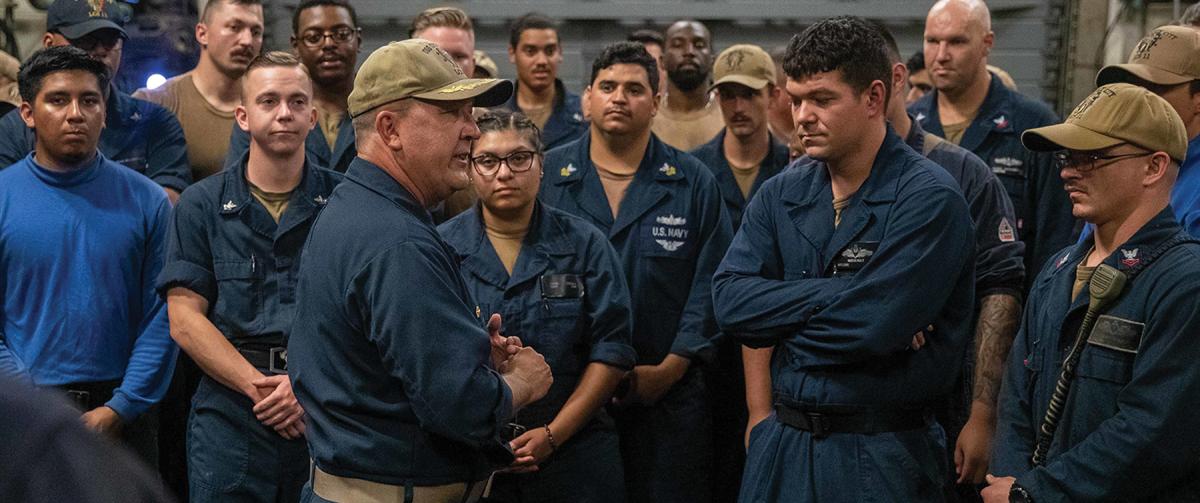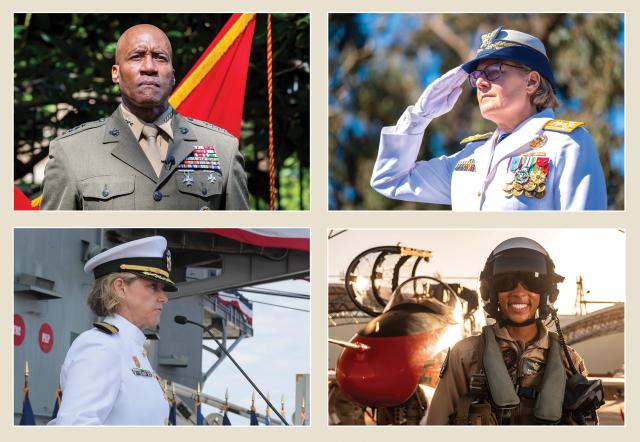Diversity has been key to U.S. victory throughout history. In 1942, for example, both the U.S. and Japanese navies simulated the Battle of Midway, with the aim of improving their war plans. Japan’s war games accurately predicted the destruction of two Japanese carriers; however, Rear Admiral Matome Ugaki—the umpire in these simulations—overruled one simulation, incorrectly surmising that the Americans had a defeatist perspective and would not attempt the modeled aggressive attacks.1 Admiral Chūchi Nagumo and Admiral Isoroku Yamamoto executed the Japanese attack based, at least in part, on Ugaki’s inaccurate assumptions.2
The U.S. Pacific Fleet also prepared for Midway. While intelligence professionals in Washington discounted the possibility of an attack at Midway, the unique backgrounds of the U.S. Pacific Fleet intelligence professionals—particularly Commander Joseph Rochefort and Lieutenant Commander Edwin Layton—allowed them to provide a more accurate assessment of Japanese battle plans. Both were fluent in Japanese and had spent significant time in Japan, including multiple tours of duty.3 Their diverse and unique perspectives provided a lens into Japanese culture, aiding the U.S. victory at Midway and shifting the tide of the war in the Pacific.
Diversity Requires Inclusion
Diversity of thinking and experience, as seen in the Midway example, can be a force multiplier. Today, the U.S. military quantifies diversity metrics by pointing to demographics. The services rightfully celebrate the many “firsts”—the first four-star Black general in the Marine Corps, the first woman to command a carrier, and the first woman officer to be nominated as Chief of Naval Operations.
Using demographic diversity metrics is indicative of the Navy’s organizational values but oversimplifies the service’s goals. Demographics are just the easiest way to measure the diversity the service seek. What is truly valued in the U.S. military, however, is inclusion of different thoughts, education, experience, and opinions, most often cultivated by diverse life experiences. Unfortunately, life does not afford every sailor and officer enough personal experiences to prepare them for every situation.
Thankfully, one can lean on the experiences of others. That requires each service member to acknowledge that the way they experience the world may not be the same as the way others do, even under similar conditions. Only then can the demographic diversity of the nation become a strategic resource for diverse thought processes—and only if there is a path for all to be included. Diversity might be measured by the demographic metrics, but inclusion means ensuring everyone with different ideas feels empowered to respectfully share them. The Navy must leverage both diversity and inclusion to deter conflict and prevail in great power competition.
In my first division officer tour, I accepted that diversity was important but struggled to understand the “why” behind my beliefs. It was not until later that I learned that diverse teams outperform their homogeneous peer groups. For example, a 2019 report from the S&P Global Market Intelligence Quantamental Research Team found that companies that appointed women to the C-suite saw a 20 percent increase in their stock prices over the ensuing two years.4 A 2021 study confirmed that companies with diverse leadership were more open to change and knowledge-building and focused on using research and development to drive more successful business engagements.5
Further, women have an outsized effect on lasting peace: Substantial inclusion of women and civil society groups in peace negotiations makes the resulting agreement 64 percent less likely to fail and 35 percent more likely to last at least 15 years.6 In the naval profession, the preservation of peace is achieved by deterring potential adversaries. Embracing diversity and inclusion—and with it the benefits of higher rates of success and enduring peace—should compel all military leaders to encourage inclusion among their ranks.
Know Your People
Studies have consistently shown that “people leave managers, not companies.”7 All sailors report to their first assignments wanting to do a good job. Leaders are entrusted to teach them skills, increase their knowledge, and use their diverse talents to accomplish the mission: to fight the ship when called on by launching weapons or recovering from damage, fire, and flooding.
Skills and knowledge are teachable, and the Navy is constantly working at a corporate level to improve these two aspects of its personnel. Talent, however, is perhaps the most important aspect of personnel. Talent explains why two equally trained and skilled sailors react differently under pressure; one may become excitable and make quick decisions, while the other calmly asks questions before following orders. Leaders benefit from diverse groups with varied talents, and they must work to ensure their sailors are put in the best position to succeed for the Navy.
As a junior leader, I was told to get to know my people. I tried to understand the different perspectives and problem-solving strategies of the sailors entrusted to me, what they wanted to do in their careers, and what motivated them. I learned that a leader’s job is to recognize and optimize the different talents in others to accomplish varied missions. Junior leaders are well-positioned to recognize and use these different talents.
The same environments that empower inclusion also foster healthier talent employment and evolution. Knowledgeable, skilled, and talented sailors are less likely to leave the Navy if they are empowered and feel they are making a difference. That only happens if senior leaders create an environment in which junior leaders can employ sailors to their maximum potential.
A Rising Tide Lifts All Ships
At the 2022 Joint Women’s Leadership Symposium—a gathering of women and men of all ranks and military services, allies, and foreign partners—Commandant of the Marine Corps General David H. Berger spoke of the difficulty recruiting and retaining talented Marines. He made it clear that he was at the conference to support his Marines.
Service members shared with top military leaders challenges they had faced throughout their careers. Some had policies used against them when they were designed to do the opposite. For example, dependent caregiver base privileges only conferred when the parent turned over legal custody of their child, or family care plans wrongfully invoked for same-day inconsequential schedule changes. These personal stories caused me to realize I had faced many of these challenges myself, or by extension through my leaders, peers, and sailors. The difference in our experiences was how our leader responded.
Everyone wants their contributions to be valued and to have access to different options, even when those options are not congruent with their leaders’ experiences. No two career paths should look the same. The aviation community has attempted to address the inflexibility of career progression to accommodate women who want to have children, but there is more to gain than retention and promotion of talented individuals. By looking at career paths in terms of gaining knowledge and skills as opposed to just jobs, mentors can consider career opportunities for individuals that take advantage of their unique talents.
My career path traditionally would have taken me through the Pentagon to manage a Navy program budget, but geographic constraints required me to stay in Hampton Roads. Fortunately, my mentors recommended a billet managing fleet maintenance budgets in Norfolk and I gained the knowledge and skills required in a budget tour. More important, our team leveraged this experience to manage carrier maintenance availabilities more effectively, culminating in a team effort to redeliver the USS Gerald R. Ford (CVN-78) to the fleet on time—even a day early.
Diverse Talent Is Decisive
In combat, whether during World War II or the current Russian invasion of Ukraine, “the side that can most efficiently deploy more effective equipment operated by better-trained personnel has typically emerged victorious. Intelligence, technological savvy, and social integration [of diverse ideas] are the assets that matter most on the modern battlefield.”8 One cannot predict when war will come, or the exact technology that will emerge preeminent on the battlefield, but the Navy can build its reservoir of diverse talent and leaders who will deploy the right equipment and manpower at the right time to counter the threat.
Potential U.S. adversaries do not value diversity of personnel or thought. Senior People’s Liberation Army officers are homogeneous in terms of age, education, gender, and ethnicity. They are entirely male and 99 percent Han Chinese.9 In addition, 58 percent of U.S. officers have served in a foreign country, while no Chinese officers in a recent study had overseas experience. Recent examination of the U.S. four-star ranks reveals that all have joint-service and operational experience.10 Only 77 percent of the 31 Chinese four-star equivalents had joint-service experience and almost half were “professional political commissars.”11
Independent thought and differences of opinion are a threat to autocracies. This is why—even as its adversaries approach technological parity—the United States still has the edge over its adversaries, just as it did at Midway many years ago. It is our people’s ideas—all our people’s ideas—that make this nation exceptional. Navy leaders must create environments in which diversity and inclusion are valued so that the right person with the right skills, knowledge, talent, diversity, and experience are put in the right positions. Diversity with inclusion will best position the Navy to deter, and, if necessary, defeat its adversaries.
1. Rib Doane, “‘You Sank My Aircraft Carrier!’ Did a Japanese War Game Predict Defeat at the Battle of Midway?” Naval War College Museum Blog, 12 June 2021.
2. Jonathan Parshall and Anthony Tully, Shattered Sword: The Untold Story of the Battle of Midway (Dulles, VA: Potomac Books, 2005).
3. Naval History and Heritage Command, “World War 2 Profiles in Duty: CDR Joseph Rochefort and LCDR Edwin Layton.”
4. Daniel Sandburg, “When Women Lead, Firms Win,” S & P Global, 16 October 2019.
5. Corrine Poast, Boris Lokshin, and Christopher Boones, “Research: Adding Women to the C-Suite Changes How Companies Think,” Harvard Business Review, 6 April 2021.
6. Jamille Biglo and Rachel Vogelstein, How Women’s Participation in Conflict Prevention and Resolution Advances U.S. Interests (New York: Council on Foreign Relations Press, 2016).
7. Curt Coffman and Marcus Buckingham, First, Break All the Rules: What the World’s Greatest Managers Do Differently (New York: Simon & Schuster, 1999).
8. Phillips Payson O’Brien, “What Ted Cruz and Tucker Carlson Don’t Understand about War,” The Atlantic, 28 September 2022.
9. Brad Lendon, “Chinese and Russian Militaries Share a Potential Weakness, New U.S. Report Finds,” CNN, 16 September 2022.
10. Lendon, “Chinese and Russian Militaries.”
11. Lendon.







